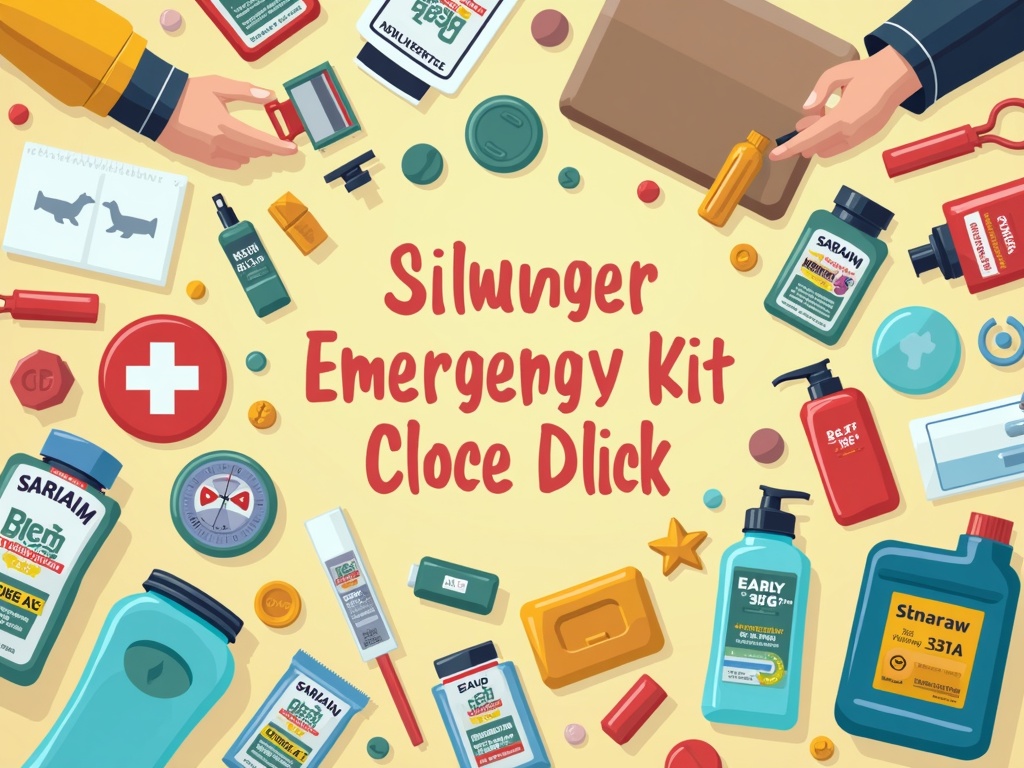How to Create a Household Emergency Kit: An Eco-Friendly Guide
Imagine the lights flicker and die. A storm rages outside, or perhaps you receive an unexpected evacuation notice. What now? In moments of crisis, a well-stocked household emergency kit can be the difference between feeling helpless and taking control. But what if you could prepare responsibly, minimizing your environmental impact while maximizing your family’s safety? This guide provides a comprehensive approach to creating a household emergency kit, with a focus on sustainable and eco-friendly choices.
Why an Eco-Friendly Emergency Kit?
Traditional emergency kits often rely on single-use items, batteries, and products with questionable environmental credentials. A conscious approach allows you to build a resilient kit that aligns with your values, reduces waste, and potentially even saves money in the long run. Consider the impact of dozens of batteries ending up in landfills or the pollution caused by manufacturing countless plastic water bottles. By choosing reusable, renewable, and sustainably sourced alternatives, you can lessen the environmental footprint of your preparedness efforts.
Essential Components of Your Emergency Kit
Every household has unique needs, but some items are universally essential for any emergency kit. Aim to assemble a kit that will sustain your family for at least 72 hours, and ideally longer.
Water: The Foundation of Survival
The Conventional Wisdom: Store at least one gallon of water per person per day for drinking and sanitation.
The Eco-Friendly Twist:
Reusable Water Containers: Invest in durable, BPA-free water bottles or jugs. Avoid single-use plastic. Clean and refill them regularly.
Water Filtration/Purification: A portable water filter or purification tablets can render questionable water sources safe to drink. Consider a filter that removes bacteria, protozoa, and viruses.
Rainwater Harvesting: If feasible, set up a system to collect rainwater (when available) for non-potable uses like washing.
Quantity Calculation: For a family of four, aim for at least 12 gallons of water for a 72-hour period.
Food: Nourishment for Body and Mind
The Conventional Wisdom: Stock non-perishable food items that require no cooking or refrigeration.
The Eco-Friendly Twist:
Nutrient-Dense, Shelf-Stable Options: Choose foods like nuts, seeds, dried fruits, whole-grain crackers, and canned beans. Opt for products with minimal packaging or packaging made from recycled materials.
DIY Energy Bars/Trail Mix: Make your own energy bars or trail mix using ingredients sourced from bulk bins to minimize packaging waste.
Home-Canned Goods: If you practice home canning, include surplus items from your pantry in your emergency kit. Remember to label them clearly with the canning date.
Avoid Over-Packaging: Remove excess packaging from purchased food items before storing them in your kit.
Calorie Considerations: Aim for at least 2,000 calories per person per day, focusing on foods that provide sustained energy.
Light and Communication: Navigating the Darkness
The Conventional Wisdom: Rely on flashlights and battery-powered radios for light and information.
The Eco-Friendly Twist:
Hand-Crank or Solar-Powered Flashlights: These eliminate the need for batteries, reducing waste and ensuring a reliable light source.
Solar-Powered Radio: A solar-powered radio can provide access to emergency broadcasts without draining batteries. Look for models with hand-crank backup.
Whistle: A simple whistle can be a lifesaver for signaling for help.
Consider a Power Bank: Rechargable by solar or hand crank: Keep your cell phone powered to communicate with others.
Battery Alternatives: If you must use batteries, opt for rechargeable ones and a solar charger.
First Aid: Addressing Injuries and Illness
The Conventional Wisdom: A standard first-aid kit is essential for treating minor injuries and illnesses.
The Eco-Friendly Twist:
Sustainable First-Aid Kit Options: Look for kits that include items made from sustainable materials, such as bamboo bandages or organic cotton gauze.
Refill and Repurpose: Instead of buying a new kit, refill an existing one with necessary supplies. Repurpose containers and packaging to minimize waste.
Natural Remedies: Consider adding natural remedies like tea tree oil (antiseptic), aloe vera (burns), and activated charcoal (digestion).
Essential First-Aid Items: Include bandages, antiseptic wipes, pain relievers, gauze pads, medical tape, and any personal medications.
Shelter and Warmth: Protection from the Elements
The Conventional Wisdom: Blankets and emergency shelters provide warmth and protection from the elements.
The Eco-Friendly Twist:
Wool Blankets: Wool is a natural, renewable resource that provides excellent insulation even when wet.
Recycled Material Blankets: Look for blankets made from recycled materials like plastic bottles.
Emergency Bivy Sack: A lightweight, reusable emergency bivy sack can provide essential protection from wind and rain.
Repurpose Old Clothing: Old sweaters, hats, and gloves can provide additional warmth.
Tools and Supplies: Essential for Practical Tasks
The Conventional Wisdom: A multi-tool, duct tape, and rope are essential for various repairs and tasks.
The Eco-Friendly Twist:
Durable, High-Quality Tools: Invest in durable, high-quality tools that will last for years. Avoid disposable or cheaply made items.
Multi-Tool: A multi-tool with a knife, pliers, screwdriver, and other essential functions can be invaluable.
Natural Fiber Rope: Opt for rope made from natural fibers like hemp or cotton.
Repair Patches: Instead of replacing damaged items, use repair patches to extend their lifespan.
Duct Tape Alternatives: Consider eco-friendly tape options that use plant-based adhesives.
Building Your Eco-Friendly Kit: Step-by-Step
1. Assess Your Needs: Consider your family size, location, and potential hazards in your area.
2. Create a List: Based on your assessment, create a detailed list of items needed.
3. Source Responsibly: Prioritize reusable, renewable, and sustainably sourced products.
4. Repurpose and Reuse: Look for opportunities to repurpose existing items or reuse containers.
5. Organize and Store: Pack your kit in a durable, waterproof container and store it in an easily accessible location.
6. Maintain and Update: Check your kit regularly, replace expired items, and update it as needed.
Beyond the Basics: Additional Considerations
Sanitation: Include biodegradable soap, toilet paper, and waste bags for sanitation purposes. Consider a portable camping toilet.
Important Documents: Store copies of important documents like identification, insurance policies, and medical records in a waterproof bag.
Cash: Keep a supply of cash on hand, as electronic transactions may not be possible during an emergency.
Personal Items: Don’t forget personal items like medications, eyeglasses, and feminine hygiene products.
Pet Supplies: If you have pets, include food, water, and any necessary medications for them.
Entertainment: Include books, games, or other activities to help pass the time during an emergency.
Gardening Supplies: Include heirloom seeds to plant in case of a food shortage.
Storing and Maintaining Your Kit
Location, Location, Location: Store your emergency kit in a cool, dry, and easily accessible location. Everyone in the household should know where it is.
Regular Check-Ups: Inspect your kit at least twice a year. Check expiration dates on food, water, and medications. Replace items as needed.
Practice Makes Perfect: Familiarize yourself and your family with the contents of the kit and how to use them. Conduct practice drills to ensure everyone knows what to do in an emergency.
Seasonal Adjustments: Adjust your kit based on the season. In winter, include extra blankets and warm clothing. In summer, include sunscreen and insect repellent.
Eco-Friendly Alternatives: A Deeper Dive
Biodegradable Wet Wipes: Standard wet wipes contribute to plastic pollution. Opt for biodegradable wipes made from plant-based materials.
Bamboo Toothbrushes and Toothpaste Tablets: Reduce plastic waste by switching to bamboo toothbrushes and toothpaste tablets.
Reusable Menstrual Products: Consider reusable menstrual cups or cloth pads as an alternative to disposable products.
DIY Cleaning Supplies: Make your own cleaning supplies using natural ingredients like vinegar, baking soda, and lemon juice.
The Mental Game: Preparedness Beyond the Physical
Building an emergency kit is about more than just gathering supplies; it’s about cultivating a mindset of preparedness. Discuss potential emergency scenarios with your family and create a plan of action. Designate meeting points, establish communication protocols, and practice emergency drills. Knowing you have a plan and the resources to cope can significantly reduce stress and anxiety during a crisis. This mental preparedness is as vital as the physical supplies in your kit.
Conclusion: Investing in a Safer, More Sustainable Future
Creating an eco-friendly household emergency kit is an investment in your family’s safety and the health of the planet. By choosing sustainable alternatives, reducing waste, and prioritizing responsible consumption, you can build a resilient kit that aligns with your values. Embrace the challenge, involve your family, and take pride in knowing that you are prepared to face whatever the future may hold, with minimal impact on the environment. Don’t wait for the storm clouds to gather – start building your eco-friendly emergency kit today. You’ll sleep better knowing you’ve taken proactive steps towards a safer, more sustainable future for yourself and your loved ones.

